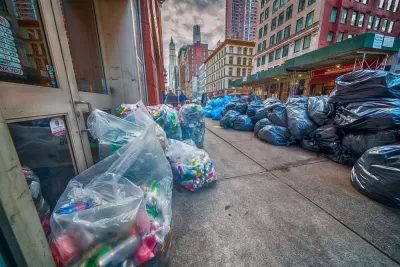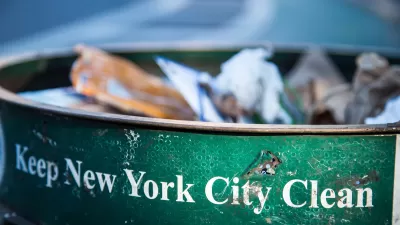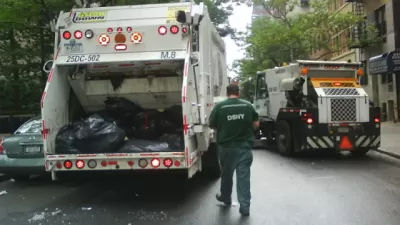The city’s sanitation department says the program, while successful on one block, would be too difficult and expensive to implement citywide.

A pilot program for ‘containerization’ of New York City’s garbage can’t be applied citywide, according to Department of Sanitation Commissioner Jessica Tisch. Kevin Duggan reports on the story for Streetsblog NYC, quoting Tisch as saying, “This is an incredibly resource-intensive pilot, and this approach is not scalable beyond its current scope.”
The department is evaluating possible avenues for containerization, the practice of streamlining trash collection by putting all trash in containers that can be picked up by automated cranes on trucks. “Tisch called the effort ‘one of the most complicated infrastructure projects’ for the city in the coming decade.”
While the pilot was successful in getting trash bags off the sidewalk, bags still ended up outside the containers, making it difficult to speed up the process since workers still have to exit trucks to load the bags. A successful container program requires frequent pickup, often once or even twice a day as opposed to the city’s current schedule of every two to three days. Meanwhile, the need to use curbside space previously reserved for parking is expected to receive pushback from some resident groups.
Residents and landlords in the pilot block, however, say the program vastly improved sanitation conditions. “On W. 45th Street, Streetsblog found about a month into the pilot that the bins kept the sidewalk blissfully clear of the usual mounds of black garbage sacks New Yorkers have to weave around on the eves of collection days.”
FULL STORY: Clean Curbs Pilot ‘Not Scalable’ Citywide, Says DSNY Commish

Alabama: Trump Terminates Settlements for Black Communities Harmed By Raw Sewage
Trump deemed the landmark civil rights agreement “illegal DEI and environmental justice policy.”

Planetizen Federal Action Tracker
A weekly monitor of how Trump’s orders and actions are impacting planners and planning in America.

The 120 Year Old Tiny Home Villages That Sheltered San Francisco’s Earthquake Refugees
More than a century ago, San Francisco mobilized to house thousands of residents displaced by the 1906 earthquake. Could their strategy offer a model for the present?

In Both Crashes and Crime, Public Transportation is Far Safer than Driving
Contrary to popular assumptions, public transportation has far lower crash and crime rates than automobile travel. For safer communities, improve and encourage transit travel.

Report: Zoning Reforms Should Complement Nashville’s Ambitious Transit Plan
Without reform, restrictive zoning codes will limit the impact of the city’s planned transit expansion and could exclude some of the residents who depend on transit the most.

Judge Orders Release of Frozen IRA, IIJA Funding
The decision is a victory for environmental groups who charged that freezing funds for critical infrastructure and disaster response programs caused “real and irreparable harm” to communities.
Urban Design for Planners 1: Software Tools
This six-course series explores essential urban design concepts using open source software and equips planners with the tools they need to participate fully in the urban design process.
Planning for Universal Design
Learn the tools for implementing Universal Design in planning regulations.
Clanton & Associates, Inc.
Jessamine County Fiscal Court
Institute for Housing and Urban Development Studies (IHS)
City of Grandview
Harvard GSD Executive Education
Toledo-Lucas County Plan Commissions
Salt Lake City
NYU Wagner Graduate School of Public Service





























